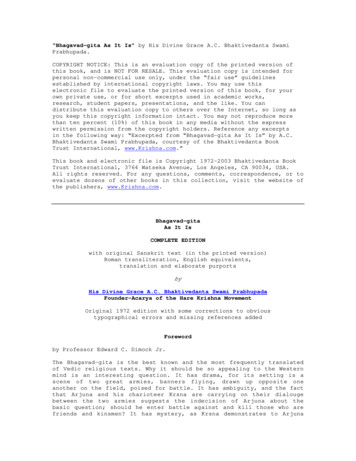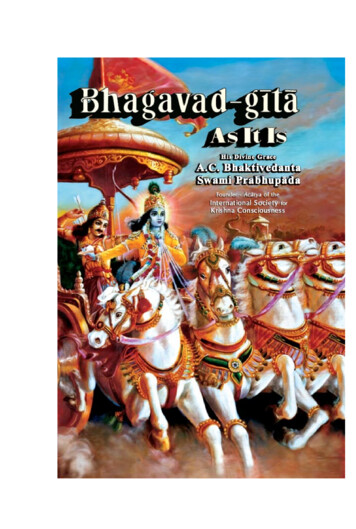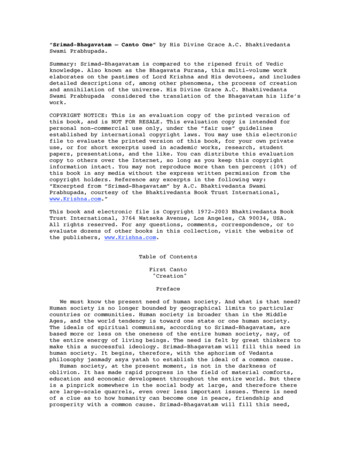
Transcription
“Caitanya-caritamrita – Adi Lila” by His Divine Grace A.C.Bhaktivedanta Swami Prabhupada.Summary: Caitanya-caritamrita is the biography of Chaitanya Mahaprabhu,written by Krsnadasa Kaviraja Goswami in the 16th century, now publishedwith elaborate translations and commentaries in English by A.C.Bhaktivedanta Swami. The multi-volume Caitanya-caritamrita is dividedinto three sections, Adi Lila, Madhya Lila, and Antya Lila, representingthe beginning, middle, and concluding pastimes of Lord ChaitanyaMahaprabhu. This file comprises the text of the several volumes thatmake up the Adi Lila section.COPYRIGHT NOTICE: This is an evaluation copy of the printed version ofthis book, and is NOT FOR RESALE. This evaluation copy is intended forpersonal non-commercial use only, under the “fair use” guidelinesestablished by international copyright laws. You may use this electronicfile to evaluate the printed version of this book, for your own privateuse, or for short excerpts used in academic works, research, studentpapers, presentations, and the like. You can distribute this evaluationcopy to others over the Internet, so long as you keep this copyrightinformation intact. You may not reproduce more than ten percent (10%) ofthis book in any media without the express written permission from thecopyright holders. Reference any excerpts in the following way:“Excerpted from “Caitanya Caritamrita” by A.C. Bhaktivedanta SwamiPrabhupada, courtesy of the Bhaktivedanta Book Trust International,www.Krishna.com.”This book and electronic file is Copyright 1974-2003 Bhaktivedanta BookTrust International, 3764 Watseka Avenue, Los Angeles, CA 90034, USA.All rights reserved. For any questions, comments, correspondence, or toevaluate dozens of other books in this collection, visit the website ofthe publishers, www.Krishna.com.PrefaceThere is no difference between the teachings of Lord Caitanyapresented here and the teachings of Lord Krsna in Bhagavad-gita. Theteachings of Lord Caitanya are practical demonstrations of Lord Krsna'steachings. Lord Krsna's ultimate instruction in Bhagavad-gita is thateveryone should surrender unto Him, Lord Krsna. Krsna promises to takeimmediate charge of such a surrendered soul. The Lord, the SupremePersonality of Godhead, is already in charge of the maintenance of thiscreation by virtue of His plenary expansion, Ksirodakasayi Visnu, butthis maintenance is not direct. However, when the Lord says that Hetakes charge of His pure devotee, He actually takes direct charge. Apure devotee is a soul who is forever surrendered to the Lord, just as achild is surrendered to his parents or an animal to its master. In thesurrendering process, one should: (1) accept things favorable fordischarging devotional service, (2) reject things unfavorable, (3)
believe firmly in the Lord's protection, (4) feel exclusively dependenton the mercy of the Lord, (5) have no interest separate from theinterest of the Lord, and (6) always feel oneself meek and humble.The Lord demands that one surrender unto Him by following these sixguidelines, but the unintelligent so-called scholars of the worldmisunderstand these demands and urge the general mass of people toreject them. At the conclusion of the Ninth Chapter of Bhagavad-gita,Lord Krsna directly says: "Engage your mind always in thinking of Me,offer obeisances and worship Me. Being completely absorbed in Me, surelyyou will come to Me." (Bg. 9.34) However, the scholarly demons misguidethe masses of people by directing them to the impersonal, unmanifest,eternal, unborn truth rather than the Personality of Godhead. Theimpersonalist Mayavadi philosophers do not accept that the ultimateaspect of the Absolute Truth isthe Supreme Personality of Godhead. Ifone desires to understand the sun as it is, one must first face thesunshine, then the sun globe and, after entering into that globe, comeface to face with the predominating deity of the sun. Due to a poor fundof knowledge, the Mayavadi philosophers cannot go beyond the Brahmaneffulgence, which may be compared to the sunshine. The Upanisads confirmthat one has to penetrate the dazzling effulgence of Brahman before onecan see the real face of the Personality of Godhead.Lord Caitanya therefore teaches direct worship of Lord Krsna, whoappeared as the foster child of the King of Vraja. He also suggests thatthe place known as Vrndavana is as good as Lord Krsna because there isno difference between the name, quality, form, pastimes, entourage andparaphernalia of Lord Krsna and Lord Krsna Himself. That is the absolutenature of the Absolute Truth.Lord Caitanya also recommended that the highest mode of worship inthe highest perfectional stage is the method practiced by the damsels ofVraja. These damsels (gopis, or cowherd girls) simply loved Krsnawithout a motive for material or spiritual gain. Caitanya alsorecommended Srimad-Bhnavatam as the spotless narration of transcendentalknowledge, and He pointed out that the highest goal in human life is todevelop unalloyed love for Krsna, the Supreme Personality of Godhead.Lord Caitanya's teachings are identical to those given by LordKapila, the original propounder of sankhya-yoga, the sankhya system ofphilosophy. This authorized system of yoga recommends meditation on thetranscendental form of the Lord. There is no question of meditating onsomething void or impersonal. One can meditate on the transcendentalform of Lord Visnu even without practicing involved sitting postures.Such meditation is called perfect samadhi. This perfect samadhi isverified at the end of the Sixth Chapter of Bhagavad-git\ where LordKrsna says: "And of all yogis, he who always abides in Me with greatfaith, worshiping Me in transcendental loving service, is mostintimately united with Me in yoga and is the highest of all." (Bg. 6.47)Lord Caitanya instructed the mass of people in the sankhyaphilosophy of acintya- bhedabheda-tattva, which maintains that theSupreme Lord is simultaneously one with and different from His creation.Lord Caitanya taught this philosophy through the chanting of the holyname of the Lord. He taught that the holy name of the Lord is the soundincarnation of the Lord and that since the Lord is the absolute whole,there is no difference between His holy name and His transcendentalform. Thus by chanting the holy name of the Lord one can directlyassociate with the Supreme Lord by sound vibration. As one practices
this sound vibration, he passes through three stages of development: theoffensive stage, the clearing stage and the transcendental stage. In theoffensive stage one may desire all kinds of material happiness, but inthe second stage one becomes clear of all material contamination. Whenone is situated on the transcendental stage, he attains the most covetedposition--the stage of loving God. Lord Caitanya taught that this is thehighest stage of perfection for human beings.Yoga practice is essentially meant for controlling the senses. Thecentral controlling factor of all the senses is the mind;therefore onefirst has to practice controlling the mind by engaging it in Krsnaconsciousness. The gross activities of the mind are expressed throughthe external senses either for the acquiring of knowledge or thefunctioning of the senses in accordance to the will. The subtleactivities of the mind are thinking, feeling and willing. In accordanceto one's consciousness, the individual is either polluted or clear. Ifone's mind is fixed on Krsna (His name, quality, form, pastimes,entourage and paraphernalia), all one's activities--both subtle andgross--become favorable. The Bhagavad-gita's process of purifyingconsciousness is the process of fixing one's mind on Krsna by talking ofHis transcendental activities, cleansing His temple, going to Histemple, seeing the beautiful transcendental form of the Lord nicelydecorated, hearing His transcendental glories, tasting food offered toHim, associating with His devotees, smelling the flowers and tulasileaves offered Him, engaging in activities for the Lord's interest, etc.No one can bring the activities of the mind and senses to a stop, butone can purify these activities through a change in consciousness. Thischange is indicated in Bhagavad- gita when Krsna tells Arjuna of theknowledge of yoga whereby one can work without fruitive results. "O sonof Prtha, when you act by such intelligence, you can free yourself fromthe bondage of works," (Bg. 2.39) A human being is sometimes restrictedin sense gratification due to certain circumstances such as disease,etc., but this is not the prescription. Without knowing the actualprocess by which the mind and senses can be controlled, less intelligentmen either try to stop the mind and senses by force, or they give in tothem and are carried away by the waves of sense gratification.The regulative principles and the rules of yoga, the varioussitting postures and breathing exercises performed in an attempt towithdraw one's senses from the sense objects are methods meant for thosewho are too much engrossed in the bodily conception of life. Theintelligent man who is situated in Krsna consciousness does not try toforcibly stop his senses from acting. Rather, he engages his senses inthe service of Krsna. No one can stop a child from playing by leavinghim inactive. A child can be stopped from engaging in nonsense by beingengaged in superior activities. The forceful restraint of senseactivities by the eight principles of yoga is recommended for inferiormen. Being engaged in the superior activities of Krsna consciousness,superior men naturally retire from the inferior activities of materialexistence.In this way Lord Caitanya teaches the science of Krsnaconsciousness. That science is absolute. Dry mental speculators try torestrain themselves from material attachment, but it is generally foundthat the mind is too strong to be controlled and that it drags them downto sensual activities. A person in Krsna consciousness does not run thisrisk. One has to engage his mind and senses in Krsna conscious
activities, and Lord Caitanya teaches one howto do this in practice.Before accepting sannyasa (the renounced order), Lord Caitanya was knownas Visvambhara. The word visvambhara refers to one who maintains theentire universe and who leads all living entities. This maintainer andleader appeared as Lord Sri Krsna Caitanya to give humanity thesesublime teachings. Lord Caitanya is the ideal teacher of life's primenecessities. He is the most munificent bestower of love of Krsna. He isthe complete reservoir of all mercies and good fortune. As confirmed inSrimad- Bhaga vatam, Bhaga vad-gita, Mah\bharata a n d th e Upanisads, He is th e S u p re m e Personality of Godhead, Krsna Himself, and He isworshipable by everyone in this age of disagreement. Everyone can joinin His sankirtana movement. No previous qualification is necessary. Just by following His teachings, anyone can become a perfect human being.If one is fortunate enough to be attracted by His features, one is sureto be successful in one's life mission. In other words, those who areinterested in attaining spiritual existence can be easily relieved fromthe clutches of maya by the grace of Lord Caitanya. These teachingspresented in this book are nondifferent from the Lord.Being engrossed in the material body, the conditioned soulincreases the pages of history by all kinds of material activities. Theteachings of Lord Caitanya can help human society stop such unnecessaryand temporary activities. By these teachings, humanity can be elevatedto the topmost platform of spiritual activity. These spiritualactivities actually begin after liberation from material bondage. Suchliberated activities in Krsna consciousness constitute the goal of humanperfection. The false prestige one acquires by attempting to dominatematerial nature is illusory. Illuminating knowledge can be acquired fromthe teachings of Lord Caitanya, and by such knowledge one can advance inspiritual existence.Everyone has to suffer or enjoy the fruits of his activity; no onecan check the laws of material nature which govern such things. As longas one is engaged in fruitive activity, he is sure to be baffled in anattempt to attain the ultimate goal of life. I sincerely hope that byunderstanding the teachings of Lord Caitanya, human society willexperience a new light of spiritual life which will open the field ofactivity for the pure soul.om tat satA.C. Bhaktivedanta SwamiBirthday of Lord CaitanyaSri-Sri-Radha-Krsna TempleNew York, N.Y.Introduction(Originally delivered as five morning lectures on Caitanyacaritamrta-- the authoritative biography of Lord Caitanya Mahaprabhu by
Krsnadasa Kaviraja Gosvami--before the International Society for KrishnaConsciousness, New York City, April 10-14,1967)The word caitanya means living force. As living entities, we canmove, but a table cannot because it does not possess living force.Movement and activity may be considered to be signs or symptoms of theliving force. Indeed, it may be said that there can be no activitywithout the living force. Although the living force is presentin thematerial condition, it is not amrta, immortal. The words caitanyacaritamrta, then, may be translated as "the character of the livingforce in immortality."But how is this living force displayed immortally? It is notdisplayed by man or any other creature in this material universe, fornone of us are immortal in these bodies. We possess the iiving force, weperform activities, and we are immortal by our nature and constitution,but the material condition into which we have been put does not allowour immortality to be displayed. It is stated in the katha Upanisad thateternality and the living force belong both to ourselves and God.Although this is true in that both God and ourselves are immortal, thereis a difference. As living entities, we perform many activities, but wehave a tendency to fall down into material nature. God has no suchtendency. Being all-powerful, He never comes under the control ofmaterial nature. Indeed, material nature is but one display of Hisinconceivable energies.On the ground we may see only clouds in the sky, but if we flyabove the clouds we can see the sun shining. From the sky, skyscrapersand cities seem very tiny; similarly, from God's position this entirematerial creation is insignificant. The tendency of the conditionedliving entity is to come down from the heights where everything can beseen in perspective. God, however, does not have this tendency. TheSupreme Lord is not subject to fall down into illusion (maya) any morethan the sun is subject to fall beneath the clouds. Because the SupremeLord is not subject to illusion, He is unconditioned; because we, asfinite living entities, are prone to fall into iilusion, we are calledconditioned. Impersonalist philosophers (Mayavadis) maintain that boththe living entity and God Himself are under the control of maya whenthey come into this material world. This may be true of the livingentity, but it is not true of God, for in all instances the materialenergy is working under His direction. Those who consider the SupremeLord to be subject to material conditioning are called fools by KrsnaHimself in Bhagavad-gita:avajananti mam mudhamanusim tanum asritamparam bhavam ajanantomama bhuta-mahesvaram"Fools deride Me when I descend in the human form. They do not know Mytranscendental nature and My supreme dominion over all that be." (Bg.9.1 1)Lord Caitanya Mahaprabhu should not be considered to be one of us.He is Krsna Himself, the supreme living entity, and as such He nevercomes under the cloud of maya. Krsna, His expansions, and even Hishigher devotees never fall into the clutches of illusion. Lord Caitanyacame to earth simply to preach krsna-bhakti, love of Krsna. In other
words, He is Lord Krsna Himself teaching the living entities the properway to approach Krsna. He is like a teacher who, seeing a student doingpoorly, takes up a pencil and writes, saying, "Do it like this: A, B,C." By this, one must notfoolishly think that the teacher is learninghis ABC's. Although He appears in the guise of a devotee, we shouldalways remember that Lord Caitanya is Krsna (God) Himself teaching ushow to become Krsna conscious, and we must study Him in that light.In Bhagavad-gita Lord Krsna sets forth the highest religiousprinciple in this way:sarva-dharman parityajyamam ekam saranam vrajaaham tvam sarva-papebhyomoksayisyami ma sucah"Abandon all varieties of religion and just surrender unto Me. I shalldeliver you from all sinful reaction. Do not fear." (Bg. 1 8.66)This may seem to be a simple instruction to follow, but invariablyour reaction is, "Oh, surrender? Give up? But I have so manyresponsibilities." And maya, illusion, says to us, "Don't do it, oryou'll be out of my clutches. Just stay in my clutches, and l'll kickyou." It is a fact that we are constantly being kicked by maya, justasthe maie-ass is kicked in the face by the she-ass when he comes forsex. Similarly, cats and dogs are always fighting and whining when theyhave sex. These are the tricks of nature. Even an elephant in the jungleis caught by the use of a trained she-elephant who leads him into a pit.Maya has many activities, and in the material world her strongestshackle is the female. Of course in actuality we are neither male norfemale--for these designations refer only to the outer dress, the body.We are all actually Krsna's servants. I n conditioned life, however, weare shackled by the iron chains which take the form of beautiful women.Thus every male is bound by sex life, and therefore when one attempts togain liberation from the material clutches, he must first learn tocontrol the sex urge. Unrestricted sex puts one fully in the clutches ofillusion. Lord Caitanya Mahaprabhu officially renounced this illusionatthe age of twenty-four, although His wife was sixteen and His motherseventy, and He was the only male member of the family. Although He wasa brahmana and was not rich, He took sannyasa, the renounced order oflife, and thus extricated Himself from family entanglement.If we wish to become fully Krsna conscious, we have to give up theshackles of maya, or, if we remain with maya, we should live in such away that we will not be subject to illusion. It is not necessary for oneto abandon his family, for there were many householders amongst LordCaitanya's closest devotees. What must be renounced is the propensityfor material enjoyment. Although Lord Caitanya approved of a householderhaving regulated sex in marriage, He was very strict with those in therenounced order, and He even banished Junior Haridasa for glancinglustfully at a young woman. The point is that one must take up aparticular path and stick to it, obeying all the rules and regulationsnecessary for success in spiritual life. It was Lord Caitanya's missionthat He teach the path of Krsna consciousness to all men and therebyenable them to partake of the immortality of spiritual life.From Caitanya-caritamrta we learn how Caitanya taught people tobecome immortal, and thus the title may be properly translated as "the
immortal character of the living force." The supreme living force is theSupreme Personality of Godhead. He is also the supreme entity. There areinnumerable living entities, and all of them are individual. This isvery easy to understand: We are all individual in thought and desires,and the Supreme Lord is also an individual person. He is different,though, in that He is the leader,the one whom no one can excel. Amongstthe created iiving entities, one being can excel another in one capacityor another. The Lord is an individual, just as the living entities areindividual, but He is different in that He is the supreme individual.God is also infallible, and in Bhagavad-gita He is addressed as Acyuta,which means, "He who never falls down." This is indicated because inBhagavad-gita Arjuna had fallen into delusion but Krsna had not. Weoften hear it said that God is infallible, and in Bhagavad-gita Krsnastates:nanyam gunebhyah kartaramyac a drastanupasyatigunebhyas ca param vettimad-bhavam so 'dhigacchati"When you see that there is nothing beyond these modes of nature in allactivities and that the Supreme Lord is transcendental to all thesemodes, then you can know My spiritual nature." (Bg. 14.19)Thus we should not think that Krsna is overpowered by the materialpotency when He is in the material world. Krsna and His incarnations arenot under the control of material nature. They are totally free. Indeed,in Srimad-Bhagavatam one who has a godly nature is actually defined asone who is not affected by the modes of material nature, although inmaterial nature. If even a devotee can attain this freedom, then what tospeak of the Supreme?The real question is how can we remain unpolluted by materialcontamination while in the material world. It was Rupa Gosvami whoexplained that we can remain uncontaminated while in the world if wesimply make it our ambition to serve Krsna. One may then justifiablyask, "How can I serve?" Obviously this is not simply a matter ofmeditation, which is just an activity of the mind, but of practicalwork. Love of Krsna's service can only be attained by working for Krsna.In such work, we should leave no resource unused. Whatever is there,whatever we have, should be used for Krsna. We can use everything:typewriters, automobiles, airplanes, missiles--anything. If we simplyspeak to people about Krsna consciousness, we are also renderingservice. If our minds, senses, speech, money and energies are thusengaged in the service of Krsna, we cannot be considered to be existingin material nature. By virtue of spiritual consciousness, or Krsnaconsciousness, we transcend the platform of material nature. It is afact that Krsna, His expansions and His devotees--that is, those whowork for Him--are not in material nature, although people with a poorfund of knowledge think that they are.Caitanya-caritamrta teaches that the spirit soul is immortal andthat ou r activities in the spiritual world are also immortal. TheMayavadis, who hold to the view that the Absolute is impersonal andformless, contend that a realized soul has no need to talk. However, theVaisnavas, who are devotees of Krsna, contend that when one reaches thestage of realization, he really begins to talk. "Previously we only
talked of nonsense," the Vaisnava says. "Now let us begin our realtalks, talks of Krsna." The Mayavadis are also fond of using the exampleof the water pot, maintaining that when a pot is not filled with waterit makes a sound, but that when it is filled it makes no sound. But arewe waterpots? How can we be compared to them? A good analogy utilizes asmany similarities between two objects as possible. A water pot is not anactive living force, but we are. Ever silent meditation may be adequatefor a water pot, but not for us. Indeed, when one has realized he has somuch to say about Krsna, twenty-four hours in a day are not sufficient.It is the fool who is celebrated as long as he does not speak, for whenhe breaks his silence his lack of knowledge is exposed. Caitanyacaritamrta shows that there are many wonderful things to discover byglorifying the Supreme.In the beginning of Caitanya-caritamrta, Krsnadasa Kaviraja Gosvamiwrites: " I offer my respects to my spiritual masters." He uses theplural here to indicate the disciplic succession. It is not that heoffers obeisances to his spiritual master alone but to the wholeparampara, the chain of disciplic succession beginning with Lord KrsnaHimself. Thus the guru is addressed in the plural to show the author'shighest respect for all the Vaisnavas. After offering obeisances to thedisciplic succession, the author pays obeisances to all other devotees,Godbrothers, the expansions of Godhead and the first manifestation ofKrsna's energy. Lord Caitanya Mahaprabhu (sometimes called KrsnaCaitanya) is the embodiment of ali of these; He is God, guru, devoteeand the expansion of God. As His associate, Nityananda, He is the firstmanifestation of energy; as Advaita, He is an incarnation; as Gadadhara,He is the internal potency; and as Srivasa, He is the marginal livingentity. Thus Krsna should not be thought of as being alone but should beconsidered as eternally existing with all His manifestation, asdescribed by Ramanujacarya. In visistadvaita philosophy, God's energies,expansions and incarnations are considered to be oneness in diversity.In other words, God is not separate from all of these; everythingtogether is God.Actually Caitanya-caritamrta is not intended for the novice, for itis the postgraduate study of spiritual knowledge. Ideally, one beginswith Bhagavad-gita and advances through Srimad-Bhagavatam to theCaitanya-caritamrta. A Ith ou gh al I these great scriptures are on thesame absolute level, for the sake of comparative study Caitanyacaritamrta is considered to be on the highest platform. Every verse init is perfectly composed. Indeed, Lord Caitanya and Nityananda arecomparedto the sun and moon in that They dissipate the darkness of the materialworld. In this instance both the sun and moon have risen together, andit is proper to offer obeisances directly to Lord Caitanya andNityananda.In the Western world where the glories of Lord Caitanya arerelatively unknown, one may inquire, "Who is Krsna Caitanya?" Thescriptural conclusion in answer to that question is that He is theSupreme Personality of Godhead. Generally in the Upanisads the SupremeAbsolute Truth is described in an impersonal way, but the personalaspect of the Absolute Truth is mentioned in the Isopanisad, where,after a description of the all-pervading, we find the following verse:hiranmayena patrena
satyasyapihitam mukhamtat tvam pusann apavrnusatya-dharmaya drstaye"O my Lord, sustainer of all that lives, Your real face is coveredby Your dazzling effulgence. Kindly remove that covering and exhibitYourself to Your pure devotee." (Sri Isopanisad, Mantra 15)The impersonalists do not have the power to go beyond theeffulgence of God and arrive at the personality from whom thiseffulgence is emanating. At the end of Isopanisad, however,there is ahymn to the Personality of Godhead. It is not that the impersonalBrahman is denied; it is also described, but that Brahman is consideredto be the glaring effulgence of the body of Caitanya. In other words,Krsna Caitanya is the basis of the impersonal Brahman. It is also statedby Krsna in Bhagavad-gita that the impersonal Brahman rests on H im(brahmano hi pratisthaham, Bg. 14.27). The Paramatma, or Supersoul,which is present within the heart of every living entity and withinevery atom of the universe, is but the partial representation ofCaitanya. Krsna Caitanya is therefore the basis of Brahman and theSupreme Personality ofGodhead as well. As the Supreme He is full in sixopulences: wealth, fame, strength, beauty, knowledge and renunciation.In short, we shouid know that He is Krsna, God, and nothing is equal toor greater than Him. There is no superior to be conceived. He is theSupreme Person.It was Rupa Gosvami, a confidential devotee taught for more thanten days continuously by Lord Caitanya, who wrote:namo maha- vac anyaya krsna-prema-pradaya tekrsnaya krsna-caitanya-namne gaura-tvise namah"I offer my respectful obeisances unto the Supreme Lord Sri KrsnaCaitanya who is more magnanimous than any other avatara, even KrsnaHimself, because He is bestowing freely what no one else has ever given-pure love of Krsna."It is not that Caitanya teaches a long and elaborate path to Godrealization. He is completely spiritual, and He begins from the point ofsurrender to Krsna. He does not pursue the paths of karma-yoga or jnanayoga or hatha-yoga but begins at the end of material existence, at thepoint where one gives up all material attachment. In Bhagavad-gita Krsnabegan His teachings by distinguishing the soul from matter and in theEighteenth Chapter concluded atthe point where the soul surrenders toHim in devotion. The Mayavadis would have all talk cease there, but atthat point the real discussion only begins. It is the Veoanta-sutrawhich begins: athato brahma- jjjnasa.- "Now let us begin to inquireabout the Supreme Absolute Truth." Rupa Gosvamithus praises Caitanya asthe most munificent incarnation of all, for He gives the greatest giftby indicating the highest form of devotional service. In other words, Heanswers the most important inquiries that anyone can make.There are different stages of devotional service and Godrealization. Strictly speaking, anyone who accepts the existence of Godis situated in devotional service. To acknowledge that God is great issomething, but not much. Caitanya, preaching as an acarya, a greatteacher, taught that we can enter into a relationship with God andactually become God's friend. In Bhagavad-gita Krsna showed Arjuna His
universal form because Arjuna was His "very dear friend." Upon seeingKrsna as the Lord of the universes, however, Arjuna actually asked Krsnato forgive the familiarity of his friendship. Caitanya goes beyond thispoint. Through Lord Caitanya we can become friends with Krsna, and thereis no limit to this friendship. We can become friends of Krsna not inawe or adoration but in complete freedom. We can even relate to God asHis father. This is not only the philosophy of Caitanya- caritamrta butof Srimad-Bhagavatam as well. Th e re a re n o other lite ratu res i nthe world in which God is treated as the son of a devotee. Usually Godis seen as the almighty Father who supplies the demands of His sons. Thegreat devotees, however, sometimes treat God as a son in their executionof devotional service. The son demands, and the father supplies, and insupplying Krsna the devotee becomes like a father. Instead of takingfrom God, we give to God. It was in this relationship that Krsna'smother, Yasoda, told the Lord, "Here, eat this or You'll die. Eatnicely." In this way Krsna, although the proprietor of everything,depends on t
face to face with the predominating deity of the sun. Due to a poor fund of knowledge, the Mayavadi philosophers cannot go beyond the Brahman effulgence, which may be compared to the sunshine. The Upanisads confirm that one has to penetrate the dazzling effulgence of Brahman before one can see the real face of the Personality of Godhead.










